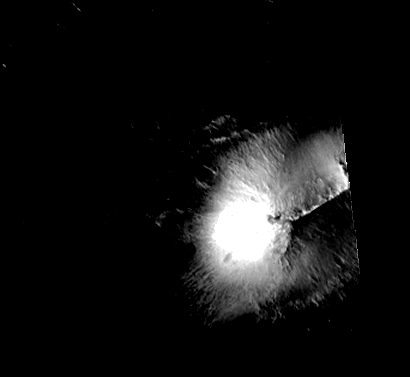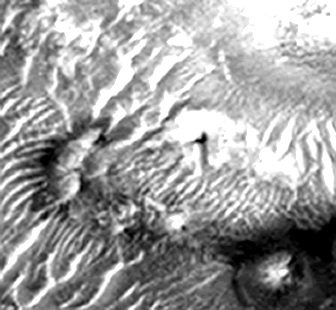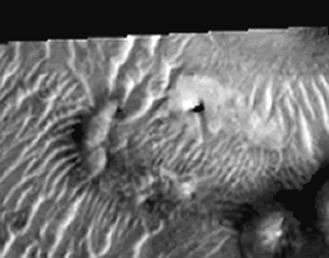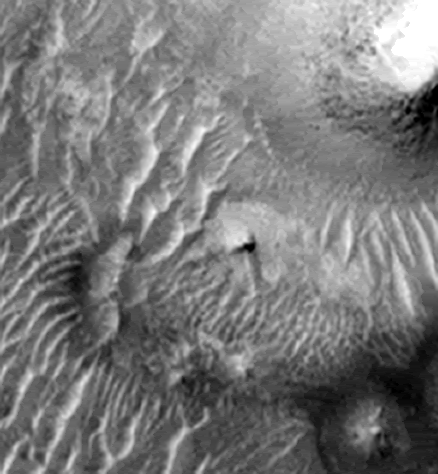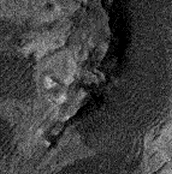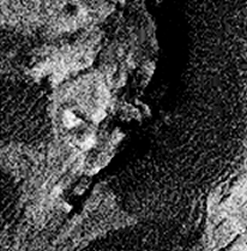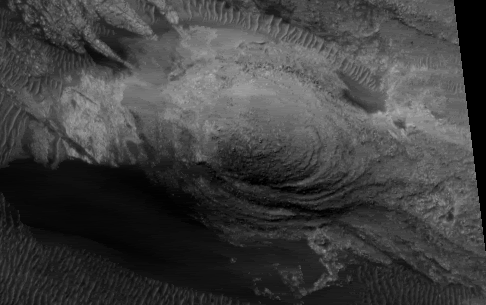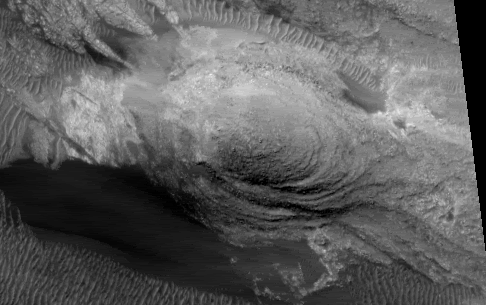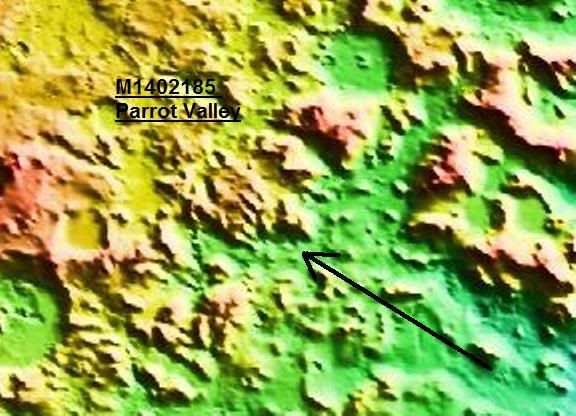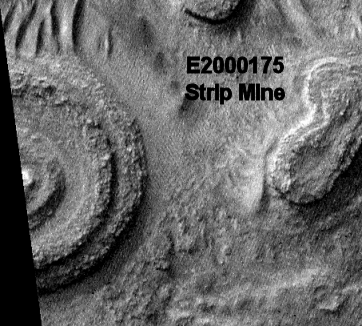- Thank you received: 0
Faces from the Chasmas
- neilderosa
-
- Offline
- Platinum Member
-

Less
More
18 years 3 months ago #9093
by neilderosa
Replied by neilderosa on topic Reply from Neil DeRosa
Awhile back this lighted object was posted by Xterrester with instructions to take note of the geometric shapes adjacent to it.
I then located the same image, MGS # M0301977, and reproduced his cropping using only brightness and contrast enhancement and similar magnification. As you can see there are no geometrical shapes, only a butte reflecting sunlight. I'm not laying any accusations here, only pointing out that we have to be careful which enhancement tools we use, and that they do not add anything not actually in the image. We also have to be careful not to magnify the image beyond the range of pixelization, because at that point one is apt to see "geometrical shapes" that are in reality only light pixels magnified.
With that in mind, we move to the East Candor Chasma, and another cylindrical object, with nothing done to it but B and C. Here is E0401514, Cylinrical object. The emission angle is .00 so the cylirical object must not be vertical.
Incidentally, I should state for the record that the smaller objects and possible faces will be quite easy to examine up close, either in person or in higher resolution images, because the details used in the creation of the art or manufacture of the object, will be very visible at the "human scale." This cannot be said for possible immense Marsglyphs. When examined up close they may be unrevealing.
Neil
I then located the same image, MGS # M0301977, and reproduced his cropping using only brightness and contrast enhancement and similar magnification. As you can see there are no geometrical shapes, only a butte reflecting sunlight. I'm not laying any accusations here, only pointing out that we have to be careful which enhancement tools we use, and that they do not add anything not actually in the image. We also have to be careful not to magnify the image beyond the range of pixelization, because at that point one is apt to see "geometrical shapes" that are in reality only light pixels magnified.
With that in mind, we move to the East Candor Chasma, and another cylindrical object, with nothing done to it but B and C. Here is E0401514, Cylinrical object. The emission angle is .00 so the cylirical object must not be vertical.
Incidentally, I should state for the record that the smaller objects and possible faces will be quite easy to examine up close, either in person or in higher resolution images, because the details used in the creation of the art or manufacture of the object, will be very visible at the "human scale." This cannot be said for possible immense Marsglyphs. When examined up close they may be unrevealing.
Neil
Please Log in or Create an account to join the conversation.
- neilderosa
-
- Offline
- Platinum Member
-

Less
More
- Thank you received: 0
18 years 3 months ago #15937
by neilderosa
Replied by neilderosa on topic Reply from Neil DeRosa
Two other images containing the same "cylindrical object" are as follows:
M0100068. Note the black spot at the top of it. "Cylinder" is center right in image.
M2301434. This image, at 2.87 m/p has almost double the resolution of the other two so it can be zoomed in further. This reveals that the "cylinrical object" may be something else, possibly another face. We need better resolution to know for sure. The "cylinder" measures around 23m wide x 90m long. The possible face would be twice as wide.
Neil
M0100068. Note the black spot at the top of it. "Cylinder" is center right in image.
M2301434. This image, at 2.87 m/p has almost double the resolution of the other two so it can be zoomed in further. This reveals that the "cylinrical object" may be something else, possibly another face. We need better resolution to know for sure. The "cylinder" measures around 23m wide x 90m long. The possible face would be twice as wide.
Neil
Please Log in or Create an account to join the conversation.
- neilderosa
-
- Offline
- Platinum Member
-

Less
More
- Thank you received: 0
18 years 3 months ago #16328
by neilderosa
Replied by neilderosa on topic Reply from Neil DeRosa
There is one face I forgot to post from W Condor Chasma. It's in the same strip that Wil Faust's mound was found in so I only became aware of it recently. Although small (2-300 m wide) it is one of the best. It has good facial proportions and detail, two well formed brows , a well formed chin and nose, and two well defined eyes with outline, iris, and oval shape, plus good shading and semetricality. He also seems to have broad shoulders. His mouth is puckered in a sense of wonder or curiosity.
Given well demonstrated artificiality elsewhere in faces on Mars, I'd say the odds against these features coming together naturally are astronomical, though I don't know the model for calculating them. Here's E0600269 "Curiosity."
Here's the same face enlarged and histogram adjusted.
Neil
Given well demonstrated artificiality elsewhere in faces on Mars, I'd say the odds against these features coming together naturally are astronomical, though I don't know the model for calculating them. Here's E0600269 "Curiosity."
Here's the same face enlarged and histogram adjusted.
Neil
Please Log in or Create an account to join the conversation.
- neilderosa
-
- Offline
- Platinum Member
-

Less
More
- Thank you received: 0
18 years 3 months ago #9094
by neilderosa
Replied by neilderosa on topic Reply from Neil DeRosa
I will take a slight detour from my planned presentation to remember the work of a man whom I am ashamed to say, I didn't even know about till one of his "anomolies" was posted recently. I'm refferring to Wil Faust. The great Petr Beckmann once said (papaphrasing) that when you examine the host of original thinkers you will find that most are cranks..but then there are others. The ones who history will show have something to say worth hearing. Reviewing some of his past material recently, I conclude that Wil was such a one.
Here is Wil's M1402185 "Parrot" from the west Argyle Basin, histogram adjusted.
And some present day pics of living parrots.
And Wil's Parrot once again with B and C. The object is about 2 km long. The anatomist in me wants to say that this is a different species of Parrot. For one thing the eye is oriented more forward than the present day specimens; for another, the top beak is shorter. But the similarities are staggering.
And "Parrot Valley," indicated with arrow and label in a MOLA image of W Argyle Basin. Incidentally, this area is not "in" the basin but just to the west of it.
Neil
Here is Wil's M1402185 "Parrot" from the west Argyle Basin, histogram adjusted.
And some present day pics of living parrots.
And Wil's Parrot once again with B and C. The object is about 2 km long. The anatomist in me wants to say that this is a different species of Parrot. For one thing the eye is oriented more forward than the present day specimens; for another, the top beak is shorter. But the similarities are staggering.
And "Parrot Valley," indicated with arrow and label in a MOLA image of W Argyle Basin. Incidentally, this area is not "in" the basin but just to the west of it.
Neil
Please Log in or Create an account to join the conversation.
- neilderosa
-
- Offline
- Platinum Member
-

Less
More
- Thank you received: 0
18 years 3 months ago #9099
by neilderosa
Replied by neilderosa on topic Reply from Neil DeRosa
Here's a structure near Wil's Parrot my brother Rich pointed out to me. It's hard to imagine such a form occurring naturally and it has analogous artificial forms here on earth. I can think of two: Ziggerauts and strip mines, though the latter are to my knowledge usually pits. This object is clearly a mound and seems to be highest in the "center." We can't see the whole structure but it looks like it spirals up from ground level to the top (center). Confirmation of the spiral form would be a true <i>a priori </i>prediction. Another <i>a priori </i>prediction (more loosely defined) is that the proximity of a "mine" to a massive structure like the Parrot is telling. It may be the source of materials for constructing the huge Mars-glyph.
Here's E2000175, "Strip mine."
Neil
Here's E2000175, "Strip mine."
Neil
Please Log in or Create an account to join the conversation.
18 years 3 months ago #9101
by jrich
Replied by jrich on topic Reply from
<blockquote id="quote"><font size="2" face="Verdana, Arial, Helvetica" id="quote">quote:<hr height="1" noshade id="quote"><i>Originally posted by neilderosa</i>
<br />Here's a structure near Wil's Parrot my brother Rich pointed out to me. It's hard to imagine such a form occurring naturally and it has analogous artificial forms here on earth. I can think of two: Ziggerauts and strip mines, though the latter are to my knowledge usually pits. This object is clearly a mound and seems to be highest in the "center." We can't see the whole structure but it looks like it spirals up from ground level to the top (center). Confirmation of the spiral form would be a true <i>a priori </i>prediction. Another <i>a priori </i>prediction (more loosely defined) is that the proximity of a "mine" to a massive structure like the Parrot is telling. It may be the source of materials for constructing the huge Mars-glyph.<hr height="1" noshade id="quote"></blockquote id="quote"></font id="quote">It is difficult to imagine how this might be a natural formation <b>only if</b> it is a spiral. Otherwise, it could be an eroded impact crater. Once we can see what the western portion of the feature looks like we will likely know with considerable certainty. These concentric rings are a pretty standard feature of impact craters, though they are often hidden beneath the surface. They are composed of either material fused into rock by the heating of the impact area or by the shattering and uplifting of harder subsurface rock due to the action of pressure waves, or both. In any case the ring material is harder than the surrounding material and erodes at a much slower rate. After the ejecta and pre-impact surface material are eroded all that is left are these concentric rings of rock which rise above the surrounding surface. And since the material closest to the center of the impact experiences greater heating it tends to be slightly harder. Thus the rings closest to the center tend to erode less than the rings and material further away and end up slightly higher with respect to them.
JR
<br />Here's a structure near Wil's Parrot my brother Rich pointed out to me. It's hard to imagine such a form occurring naturally and it has analogous artificial forms here on earth. I can think of two: Ziggerauts and strip mines, though the latter are to my knowledge usually pits. This object is clearly a mound and seems to be highest in the "center." We can't see the whole structure but it looks like it spirals up from ground level to the top (center). Confirmation of the spiral form would be a true <i>a priori </i>prediction. Another <i>a priori </i>prediction (more loosely defined) is that the proximity of a "mine" to a massive structure like the Parrot is telling. It may be the source of materials for constructing the huge Mars-glyph.<hr height="1" noshade id="quote"></blockquote id="quote"></font id="quote">It is difficult to imagine how this might be a natural formation <b>only if</b> it is a spiral. Otherwise, it could be an eroded impact crater. Once we can see what the western portion of the feature looks like we will likely know with considerable certainty. These concentric rings are a pretty standard feature of impact craters, though they are often hidden beneath the surface. They are composed of either material fused into rock by the heating of the impact area or by the shattering and uplifting of harder subsurface rock due to the action of pressure waves, or both. In any case the ring material is harder than the surrounding material and erodes at a much slower rate. After the ejecta and pre-impact surface material are eroded all that is left are these concentric rings of rock which rise above the surrounding surface. And since the material closest to the center of the impact experiences greater heating it tends to be slightly harder. Thus the rings closest to the center tend to erode less than the rings and material further away and end up slightly higher with respect to them.
JR
Please Log in or Create an account to join the conversation.
Time to create page: 0.280 seconds


